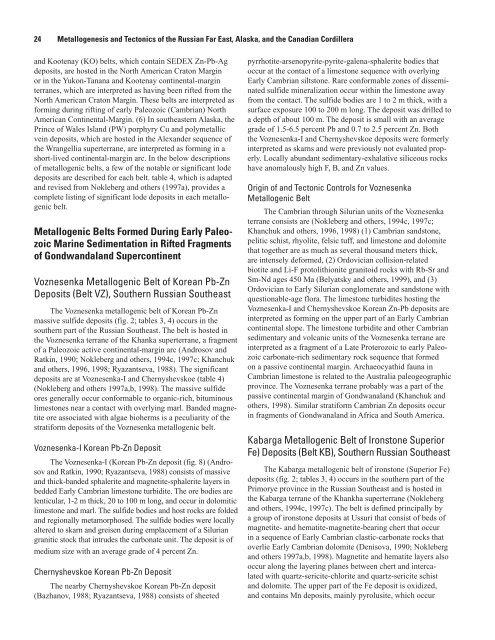USGS Professional Paper 1697 - Alaska Resources Library
USGS Professional Paper 1697 - Alaska Resources Library
USGS Professional Paper 1697 - Alaska Resources Library
You also want an ePaper? Increase the reach of your titles
YUMPU automatically turns print PDFs into web optimized ePapers that Google loves.
24 Metallogenesis and Tectonics of the Russian Far East, <strong>Alaska</strong>, and the Canadian Cordillera<br />
and Kootenay (KO) belts, which contain SEDEX Zn-Pb-Ag<br />
deposits, are hosted in the North American Craton Margin<br />
or in the Yukon-Tanana and Kootenay continental-margin<br />
terranes, which are interpreted as having been rifted from the<br />
North American Craton Margin. These belts are interpreted as<br />
forming during rifting of early Paleozoic (Cambrian) North<br />
American Continental-Margin. (6) In southeastern <strong>Alaska</strong>, the<br />
Prince of Wales Island (PW) porphyry Cu and polymetallic<br />
vein deposits, which are hosted in the Alexander sequence of<br />
the Wrangellia superterrane, are interpreted as forming in a<br />
short-lived continental-margin arc. In the below descriptions<br />
of metallogenic belts, a few of the notable or significant lode<br />
deposits are described for each belt. table 4, which is adapted<br />
and revised from Nokleberg and others (1997a), provides a<br />
complete listing of significant lode deposits in each metallogenic<br />
belt.<br />
Metallogenic Belts Formed During Early Paleozoic<br />
Marine Sedimentation in Rifted Fragments<br />
of Gondwandaland Supercontinent<br />
Voznesenka Metallogenic Belt of Korean Pb-Zn<br />
Deposits (Belt VZ), Southern Russian Southeast<br />
The Voznesenka metallogenic belt of Korean Pb-Zn<br />
massive sulfide deposits (fig. 2; tables 3, 4) occurs in the<br />
southern part of the Russian Southeast. The belt is hosted in<br />
the Voznesenka terrane of the Khanka superterrane, a fragment<br />
of a Paleozoic active continental-margin arc (Androsov and<br />
Ratkin, 1990; Nokleberg and others, 1994c, 1997c; Khanchuk<br />
and others, 1996, 1998; Ryazantseva, 1988). The significant<br />
deposits are at Voznesenka-I and Chernyshevskoe (table 4)<br />
(Nokleberg and others 1997a,b, 1998). The massive sulfide<br />
ores generally occur conformable to organic-rich, bituminous<br />
limestones near a contact with overlying marl. Banded magnetite<br />
ore associated with algae bioherms is a peculiarity of the<br />
stratiform deposits of the Voznesenka metallogenic belt.<br />
Voznesenka-I Korean Pb-Zn Deposit<br />
The Voznesenka-I (Korean Pb-Zn deposit (fig. 8) (Androsov<br />
and Ratkin, 1990; Ryazantseva, 1988) consists of massive<br />
and thick-banded sphalerite and magnetite-sphalerite layers in<br />
bedded Early Cambrian limestone turbidite. The ore bodies are<br />
lenticular, 1-2 m thick, 20 to 100 m long, and occur in dolomitic<br />
limestone and marl. The sulfide bodies and host rocks are folded<br />
and regionally metamorphosed. The sulfide bodies were locally<br />
altered to skarn and greisen during emplacement of a Silurian<br />
granitic stock that intrudes the carbonate unit. The deposit is of<br />
medium size with an average grade of 4 percent Zn.<br />
Chernyshevskoe Korean Pb-Zn Deposit<br />
The nearby Chernyshevskoe Korean Pb-Zn deposit<br />
(Bazhanov, 1988; Ryazantseva, 1988) consists of sheeted<br />
pyrrhotite-arsenopyrite-pyrite-galena-sphalerite bodies that<br />
occur at the contact of a limestone sequence with overlying<br />
Early Cambrian siltstone. Rare conformable zones of disseminated<br />
sulfide mineralization occur within the limestone away<br />
from the contact. The sulfide bodies are 1 to 2 m thick, with a<br />
surface exposure 100 to 200 m long. The deposit was drilled to<br />
a depth of about 100 m. The deposit is small with an average<br />
grade of 1.5-6.5 percent Pb and 0.7 to 2.5 percent Zn. Both<br />
the Voznesenka-I and Chernyshevskoe deposits were formerly<br />
interpreted as skarns and were previously not evaluated properly.<br />
Locally abundant sedimentary-exhalative siliceous rocks<br />
have anomalously high F, B, and Zn values.<br />
Origin of and Tectonic Controls for Voznesenka<br />
Metallogenic Belt<br />
The Cambrian through Silurian units of the Voznesenka<br />
terrane consists are (Nokleberg and others, 1994c, 1997c;<br />
Khanchuk and others, 1996, 1998) (1) Cambrian sandstone,<br />
pelitic schist, rhyolite, felsic tuff, and limestone and dolomite<br />
that together are as much as several thousand meters thick,<br />
are intensely deformed, (2) Ordovician collision-related<br />
biotite and Li-F protolithionite granitoid rocks with Rb-Sr and<br />
Sm-Nd ages 450 Ma (Belyatsky and others, 1999), and (3)<br />
Ordovician to Early Silurian conglomerate and sandstone with<br />
questionable-age flora. The limestone turbidites hosting the<br />
Voznesenka-I and Chernyshevskoe Korean Zn-Pb deposits are<br />
interpreted as forming on the upper part of an Early Cambrian<br />
continental slope. The limestone turbidite and other Cambrian<br />
sedimentary and volcanic units of the Voznesenka terrane are<br />
interpreted as a fragment of a Late Proterozoic to early Paleozoic<br />
carbonate-rich sedimentary rock sequence that formed<br />
on a passive continental margin. Archaeocyathid fauna in<br />
Cambrian limestone is related to the Australia paleogeographic<br />
province. The Voznesenka terrane probably was a part of the<br />
passive continental margin of Gondwanaland (Khanchuk and<br />
others, 1998). Similar stratiform Cambrian Zn deposits occur<br />
in fragments of Gondwanaland in Africa and South America.<br />
Kabarga Metallogenic Belt of Ironstone Superior<br />
Fe) Deposits (Belt KB), Southern Russian Southeast<br />
The Kabarga metallogenic belt of ironstone (Superior Fe)<br />
deposits (fig. 2; tables 3, 4) occurs in the southern part of the<br />
Primorye province in the Russian Southeast and is hosted in<br />
the Kabarga terrane of the Khankha superterrane (Nokleberg<br />
and others, 1994c, 1997c). The belt is defined principally by<br />
a group of ironstone deposits at Ussuri that consist of beds of<br />
magnetite- and hematite-magnetite-bearing chert that occur<br />
in a sequence of Early Cambrian clastic-carbonate rocks that<br />
overlie Early Cambrian dolomite (Denisova, 1990; Nokleberg<br />
and others 1997a,b, 1998). Magnetite and hematite layers also<br />
occur along the layering planes between chert and intercalated<br />
with quartz-sericite-chlorite and quartz-sericite schist<br />
and dolomite. The upper part of the Fe deposit is oxidized,<br />
and contains Mn deposits, mainly pyrolusite, which occur
















